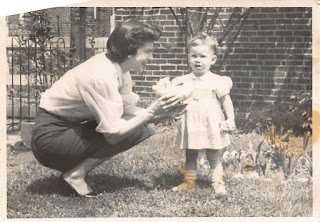 |
| Chris and Marilyn, Salton Sea, 2019 |
Isotope Queen
Marilyn Fogel’s Scientific Memoirs
August 3, 2019
“It is my opinion that for a laboratory as small as
ours, the main thing in choosing a new staff member is to find a man with a set of good ideas, the
ability to carry them out and the personal drive to work alone. I would
consider then the nature of the work he
wished to do. The laboratory is too small to do everything, and is even too
small to do everything that is significant in the earth sciences. It then seems
to me that the type of man that is
available is of prime importance… It would be well to
have someone who has had some training along biological lines.”
Thomas C. Hoering to Philip H. Abelson, 1963
 |
| Mother Florence Fogel and Marilyn, 1953 |
My Ph.D. work in 1974 was funded by a
NASA Exobiology grant. Later in my career, it came as no surprise that I would
be fascinated by the search for life in the universe. My work came full circle
30 years later with the study of astrobiology in the Arctic, India, and other
extreme environments.
The majority of my professional career
took place at the Carnegie Institution of Washington’s Geophysical Laboratory.
I was fortunate to land there at a time when biogeochemistry was in its
infancy. Without fully being aware of where I was headed, I jumped with both
feet into multi-disciplinary work, not being afraid to collaborate with smart
people in many different fields along the way. Carnegie encouraged its staff
scientists to think broadly, try new things, and be creative. In the early days
from Carnegie Institution’s inception until about 1980, we did our research
without significant government funding. My early work was supported in part by
grants from private foundations, money that I may have never seen explicitly,
but nonetheless provided support for my postdocs, lab supplies, fieldwork, and
an occasional conference.
As I grew more experienced, I
transformed from a shy, quiet, perpetually youthful looking woman into a more
outgoing leader. Always serious, it took awhile for me to realize that being
quiet did not help my career. I attribute the transformation to a supportive
husband, motherhood, and great colleagues. My husband, Christopher Swarth,
forced me, pleasantly, to stand up for myself and speak out when I had an
opinion. As a mother of two young children, I learned more about how to work
effectively as a scientist, while taking care of others. Eventually, I
developed personal relationships with Geophysical Laboratory scientists, Tom
Hoering and Doug Rumble, as well as others who supported my ideas and
recognized the value of my hard work.
Mentoring young scientists along the
way became one of the most rewarding aspects of my career. Carnegie supported a
vigorous postdoctoral program, and typically I worked with one to three
postdocs at any one time. Although the Carnegie Institution did not grant
academic degrees, I served on the committees of many graduate students and was
an active participant in their research. Bright undergrads and high school
students somehow magically appeared each summer and enriched my career with
their innate fascination for science. I learned much from these folks.
Below is the story of my career thus
far (1970 to 2019). Its path has
influenced many of my direct associates as well as those related to them. My
academic family tree, thanks to a lifetime of mentorship from people who cared
and were smart, is healthy, active, and strong. These relationships buoy me
daily, especially as I transition to the next phase of my career. In 2016, I
was diagnosed with amyotrophic lateral sclerosis (ALS; Motor Neuron Disease in
Europe), which abruptly changed the way that I had planned to end my career. No
longer able to travel at the drop of a hat to far-flung field areas; no longer
able to wield the wrenches in the lab; and finding it difficult to travel to
conferences, I have had to consider what is most important in this phase of my
life and why it might be so. Accordingly, it was finally the right time to
write a memoir of the experiences I’ve had as a scientist that I hope will
serve as inspiration for young and old readers alike on the joys and challenges
of a full, intellectual and personal life.
Science today is as important for
advancing civilization as it was 50 years ago, but how it’s carried out and by
whom is shifting. China has surpassed Japan as the Asian science powerhouse.
The European Union is investing large sums of its resources into bigger
projects that the United States is not competing with. Consequently, how
science is done in America and whether or not as a country we will be able to
maintain a healthy scientific agenda remains, in my opinion, to be seen. How
are young people being introduced to a scientific career? Will they have the
freedom that I enjoyed to pursue the science I felt was important? Students
that I talk to at the University of California are curious about how a career
gets started and how it evolves. In particular, early career women want to know
how they should have the right amount of competitive spirit versus being
considered bitchy and nagging. I hope that the stories of what I journeyed
through as a scientist, person, wife, and mother are helpful for early career
scientists figuring out how to navigate their lives.





Thank you for beginning this blog/writings. You have been a significant inspiration of mine since I was a wee isotope kid (although I most often watched your work and results quietly from a distance), and learnt from a good isotope pedigree. Mahalo, gracias, merci, and kia mihi for these insights.
ReplyDelete